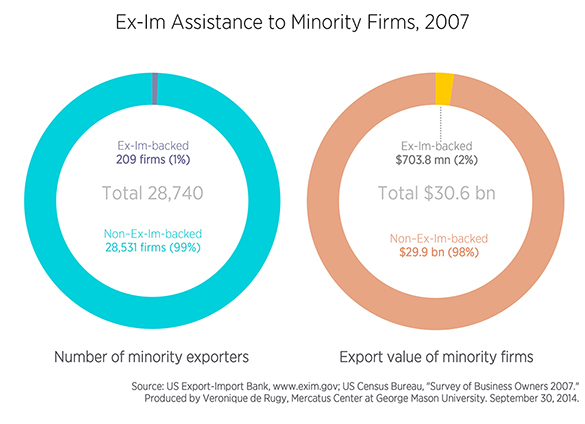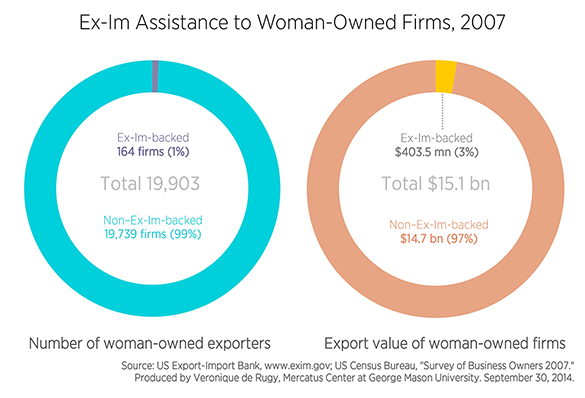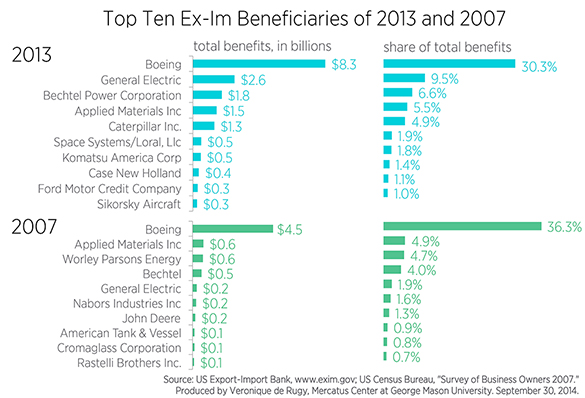- | Government Spending Government Spending
- | Data Visualizations Data Visualizations
- |
Public Data Suggest Ex-Im Bank Is Not for Everyone
This week’s charts use data from the Export-Import Bank and the Census Bureau to display assistance dispersion among minority- and women-owned exporting firms as a proportion of those in the general economy, along with the top 10 firms that receive assistance and the proportion of their benefits to the whole.
Defenders of the Export-Import Bank sometimes counter criticisms of cronyism by arguing that anyone can apply for its subsidies. This claim is not only technically incorrect—Ex-Im Bank’s charter clearly prohibits certain industries, projects, and countries from receiving assistance—it is also not very meaningful. To determine whether Ex-Im assistance is truly “for everyone,” we must look at the distribution of assistance.
This week’s charts use data from the Export-Import Bank and the Census Bureau to display assistance dispersion among minority- and women-owned exporting firms as a proportion of those in the general economy, along with the top 10 firms that receive assistance and the proportion of their benefits to the whole. The charts show that despite the rhetoric, Ex-Im assistance primarily benefits a handful of large corporations while barely penetrating the demographics that are used to justify the Ex-Im Bank’s existence.
The first chart compares Ex-Im data on the number of minority-owned exporting firms and export value supported by Ex-Im Bank to the total number of minority-owned firms and export value in the US economy as reported by the Census. The data are from 2007, which is the most recent year for which the Census report is currently available. The circle to the left compares the portion of Ex-Im-backed minority-owned exporting firms (in purple) to the total number of minority-owned exporting firms in the entire economy (in blue). Less than one percent of the 28,531 minority-owned exporting firms in the United States receive any Ex-Im assistance. The circle to the right compares the portion of Ex-Im-backed minority-owned export value (in yellow) to the total amount of minority-owned export value in the entire economy (in pink). A little over two percent of the $30.6 billion in total minority-owned export value received Ex-Im assistance that year. The chart shows that Ex-Im Bank is hardly responsible for the successes of minority-owned exports.
The second chart uses the same datasets to display Ex-Im Bank’s influence on women-owned exporting firms. The circle to the left compares the portion of Ex-Im-backed women-owned exporting firms (in purple) to the total number of women-owned exporting firms in the economy (in blue). Again, less than one percent of the 19,739 women-owned exporting firms in the United States receive any Ex-Im assistance. The circle to the right compares the portion of Ex-Im-backed women-owned export value (in yellow) to the total amount of women-owned export value in the economy (in pink). Almost three percent of the $15.1 billion in total women-owned export value received Ex-Im assistance that year. The chart shows that Ex-Im Bank does not significantly influence the overall number and exports of women-owned exporting firms, either.
The final charts above display the top 10 corporations that received Ex-Im assistance in 2007 and 2013, using public Ex-Im data. The top beneficiaries are displayed by descending order of benefits on the left, along with the total assistance received for that year, while each beneficiary’s percentage share of total Ex-Im benefits for the year is displayed on the right. The charts show that the vast majority of Ex-Im assistance goes to large corporations rather than small businesses, minority-owned exporters, or woman-owned exporters. In 2007, a little over $7 billion, or 57 percent, of the total $12.4 billion in assistance went to 10 companies. In 2013, $17.4 billion, or 64 percent, of the total $27.4 billion in assistance accrued to the top 10 beneficiaries. In both cases, Boeing leads the pack, pulling in 36 percent of all funds in 2007 and 30 percent of all funds in 2013.
These charts suggest that while assistance from the Ex-Im Bank might be technically available to a wide variety of exporters in theory, its subsidies tend to benefit many of the same large corporations year after year in practice. The data give little grounds to claim that the Export-Import Bank primarily benefits the average person and is fairly distributed among all.




